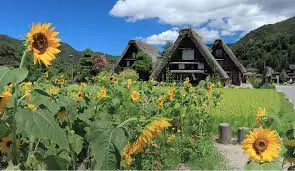Welcome to Shirakawa-go: A UNESCO World Heritage Site
Shirakawa-go, a small village nestled in the Shogawa River Valley in Gifu Prefecture, Japan, is renowned for its captivating beauty and unique cultural heritage. Designated a UNESCO World Heritage Site in 1995, Shirakawa-go offers visitors a glimpse into a traditional way of life seemingly untouched by time. The village is famed for its gassho-style farmhouses, some of which are over 250 years old. These architectural marvels, with their distinctive steep thatched roofs, are a testament to the ingenuity and resilience of the people who built them.

The Gassho-style Farmhouses: An Architectural Wonder
The term “gassho-zukuri” translates to “constructed like hands in prayer,” and it’s easy to see why. The steep roofs of these farmhouses, made without nails, resemble the hands of Buddhist monks pressed together in prayer. This unique design serves a practical purpose as well:
- Snow Protection: The steep angle allows heavy snow to slide off easily, preventing collapse during the harsh winters.
- Sericulture: The spacious attics were traditionally used for sericulture, the cultivation of silkworms.

Ogimachi Village: The Heart of Shirakawa-go
The most popular destination within Shirakawa-go is Ogimachi Village, where over 100 gassho-style houses are clustered together, creating a picturesque scene. Many of these houses are open to the public, offering a fascinating insight into the lives of the villagers.
- Wada House: This is one of the largest and most impressive gassho-style houses in Ogimachi. It showcases the traditional layout and furnishings of a wealthy farming family. (Address: Ogimachi, Shirakawa Village, Ono District, Gifu 501-5627, Japan. Open: 9:00 AM – 5:00 PM)
- Kanda House: This house offers a glimpse into the history of sericulture in Shirakawa-go, with exhibits on silkworm rearing and silk production. (Address: Ogimachi, Shirakawa Village, Ono District, Gifu 501-5627, Japan. Open: 9:00 AM – 5:00 PM)

Exploring the Village: Things to Do
- Wander through the village: Take your time to stroll through the charming streets of Ogimachi, admiring the gassho-style houses and soaking up the peaceful atmosphere.
- Visit the Shirakawa-go Gassho-style Farmhouse Open Air Museum: This museum features several relocated gassho-style houses, offering a comprehensive look at their construction and history. (Address: Ogimachi 107, Shirakawa, Ono District, Gifu 501-5627, Japan. Open: 8:40 AM – 5:00 PM)
- Hike to Shiroyama Viewpoint: For stunning panoramic views of the village, hike up to the Shiroyama Viewpoint. The view is particularly breathtaking in the autumn when the leaves change color.
- Tip: Wear comfortable shoes and bring water, as the hike can be steep in some sections.
- Experience the Shirakawa-go winter light-up: If you’re visiting in winter, don’t miss the magical illumination of the village during the special light-up events.
- Tip: Book your accommodation and transportation in advance, as these events attract many visitors.

Beyond the Village: Discovering the Surrounding Area
While Ogimachi Village is the main attraction, the surrounding area offers plenty to explore.
Gokayama: Another Gassho-style Village
Just a short distance from Shirakawa-go lies Gokayama, another UNESCO World Heritage Site with gassho-style farmhouses. Gokayama is less crowded than Shirakawa-go and offers a more tranquil experience.
- Ainokura Village and Suganuma Village: These two villages in Gokayama are known for their beautifully preserved gassho-style houses and stunning natural landscapes.

Historical Sites and Museums
- Shirakawa Hachiman Shrine: This ancient shrine is dedicated to the god of war and is known for its beautiful architecture and peaceful atmosphere. (Address: Ogimachi, Shirakawa Village, Ono District, Gifu 501-5620, Japan)
- Gifu Prefectural Museum of History: Learn about the history and culture of the Gifu region, including the unique traditions of Shirakawa-go. (Address: 1-1-1 Yanagase, Gifu, Gifu Prefecture 501-0131, Japan. Open: 9:30 AM – 5:00 PM)
Natural Wonders
- Mount Hakusan: This majestic mountain is a popular hiking destination, offering breathtaking views of the surrounding countryside.
- Tip: Check the weather conditions before hiking and be prepared for varying temperatures.
- Shogawa River: Enjoy a scenic boat ride or go fishing on the Shogawa River, which flows through the heart of Shirakawa-go.

Practical Travel Tips
Getting to Shirakawa-go
- By Bus: Nohi Bus operates highway buses from Takayama, Kanazawa, and Nagoya to Shirakawa-go.
- Tip: Purchase your bus tickets in advance, especially during peak season.
- By Car: Shirakawa-go is accessible by car via the Tokai-Hokuriku Expressway.
- Tip: Be aware that parking can be limited in the village.
Getting Around Shirakawa-go
- Walking: The village is compact and easily explored on foot.
- Bicycle: Bicycle rentals are available for those who want to explore the surrounding area.
- Local Bus: There is a local bus service that connects the different villages within Shirakawa-go.
Currency Exchange
Japanese Yen (JPY) is the currency used in Japan. ATMs are available in the village, and some shops and restaurants accept credit cards.
Cultural Etiquette
- Bowing: Bowing is a common form of greeting in Japan.
- Shoes: It is customary to remove your shoes before entering homes and temples.
- Chopsticks: Avoid sticking your chopsticks upright in your rice bowl, as this is considered bad luck.
Transliteration: Essential Japanese Phrases
- Greetings
- Hello: Konnichiwa (Kon-ni-chi-wa)
- Good morning: Ohayo gozaimasu (O-ha-yo go-za-i-masu)
- Good evening: Konbanwa (Kon-ban-wa)
- Thank you: Arigato gozaimasu (A-ri-ga-to go-za-i-masu)
- Excuse me: Sumimasen (Su-mi-ma-sen)
- Directions
- Where is the [place]?: [Place] wa doko desu ka? ([Place] wa do-ko de-su ka?)
- To the right: Migi e (Mi-gi e)
- To the left: Hidari e (Hi-da-ri e)
- Straight ahead: Massugu (Mas-su-gu)
- Dining
- I would like to order: Chumon o onegai shimasu (Chu-mon o o-ne-gai shi-masu)
- Delicious: Oishii desu (O-i-shii de-su)
- Water, please: Ohiya o kudasai (O-hi-ya o ku-da-sai)
- Emergencies
- Help!: Tasukete! (Ta-su-ke-te!)
- I need a doctor: Isha o yonde kudasai (I-sha o yon-de ku-da-sai)
- Police: Keisatsu (Kei-sa-tsu)
Real-life Stories: Unforgettable Experiences in Shirakawa-go
- A Winter Wonderland: “Visiting Shirakawa-go during the winter light-up was like stepping into a fairytale. The snow-covered gassho-style houses illuminated against the night sky was a sight I’ll never forget.” – Sarah, a traveler from the UK.
- Cultural Immersion: “Staying in a traditional gassho-style farmhouse was an incredible experience. We learned so much about the local culture and way of life.” – Kenji, a traveler from Tokyo.
Why Visit Shirakawa-go?
Shirakawa-go offers a unique blend of history, culture, and natural beauty. It’s a place where you can step back in time and experience a traditional way of life that has been preserved for centuries. Whether you’re exploring the charming village, hiking in the surrounding mountains, or simply enjoying the peaceful atmosphere, a visit to Shirakawa-go is sure to be an unforgettable experience.
Plan Your Trip to Shirakawa-go Today!
Ready to experience the magic of Shirakawa-go? Start planning your trip today! Browse our selection of tours and accommodation options to find the perfect fit for your travel needs.
Explore Shirakawa-go Tours and Accommodation
Shirakawa-go Throughout the Seasons
Shirakawa-go is a destination that transforms with the seasons, offering unique experiences year-round.
- Spring (April-May)
- Cherry Blossoms: Witness the beauty of cherry blossoms blooming around the village, adding a touch of pink to the landscape.
- Planting Season: Observe the villagers preparing the rice paddies for planting, a glimpse into the agricultural traditions of Shirakawa-go.
- Summer (June-August)
- Lush Greenery: The village is enveloped in vibrant green foliage, creating a refreshing and picturesque setting.
- Firefly Watching: In early summer, witness the magical sight of fireflies illuminating the night sky.
- Autumn (September-November)
- Fall Foliage: Experience the breathtaking beauty of autumn leaves transforming the mountainsides into a tapestry of red, orange, and gold.
- Harvest Season: Observe the villagers harvesting rice and other crops, a testament to their connection with the land.
- Winter (December-March)
- Snow-Covered Village: Shirakawa-go becomes a winter wonderland, with gassho-style houses blanketed in snow.
- Winter Light-up: Witness the magical illumination of the village during special light-up events, creating a truly enchanting atmosphere. (Note: Dates and times for the winter illuminations vary each year, so be sure to check the official website for the latest information.)
Preserving Traditions: The Shirakawa-go Community
The residents of Shirakawa-go are actively involved in preserving their unique cultural heritage.
- Community Involvement
- Traditional Crafts: Learn about traditional crafts like washi paper-making and woodworking, and even participate in workshops.
- Local Festivals: Experience the vibrant culture of Shirakawa-go by attending local festivals, such as the Doburoku Festival in autumn.
- Sustainable Tourism
- Eco-friendly Practices: Shirakawa-go is committed to sustainable tourism practices, aiming to protect the environment and preserve its cultural heritage for future generations.
- Respectful Visiting: Visitors are encouraged to be mindful of the local community and environment, ensuring a positive impact on this special place.
Accommodation in Shirakawa-go
Experience the charm of staying in a traditional gassho-style farmhouse.
- Minshuku (Guesthouses)
- Authentic Experience: Many gassho-style houses operate as minshuku, offering a unique opportunity to experience traditional Japanese hospitality.
- Home-cooked Meals: Enjoy delicious home-cooked meals featuring local ingredients, often served in a communal setting.

- Other Accommodation Options
- Hotels: There are also modern hotels available in the surrounding area for those who prefer contemporary amenities.
- Ryokan (Traditional Inns): Experience the elegance of a traditional Japanese inn with tatami mat rooms and onsen (hot spring baths).
Tips for Planning Your Visit
- Best Time to Visit: Shirakawa-go is beautiful year-round, but the most popular times to visit are during the autumn foliage season (late October to early November) and the winter light-up events.
- Reservations: If you plan to stay overnight in a gassho-style farmhouse, it’s essential to make reservations in advance, especially during peak season.
- Respectful Photography: Be mindful of the villagers’ privacy when taking photographs. Always ask for permission before taking photos of people or their homes.
Shirakawa-go: A Timeless Treasure
Shirakawa-go is more than just a picturesque village; it’s a living testament to the enduring spirit of a community and its harmonious relationship with nature. A visit to this UNESCO World Heritage Site offers a unique opportunity to connect with Japan’s rich cultural heritage and experience the tranquility of a bygone era.













